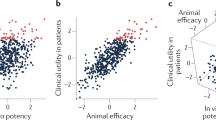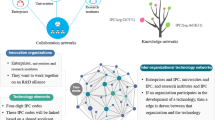Abstract
Alliances, which are a key component of the research and development (R&D) strategies of most major pharmaceutical companies, demand significant management time and resources. There is no doubt that considerable value can be derived from R&D alliances, and much has been written about how companies can maximize such value, but the issue of how the associated risks can be minimized has been neglected in comparison. Here, we summarize recent trends in alliance formation and discuss approaches to minimize risk in alliances, which are growing in importance as alliance activity increases.
This is a preview of subscription content, access via your institution
Access options
Subscribe to this journal
Receive 12 print issues and online access
$209.00 per year
only $17.42 per issue
Buy this article
- Purchase on Springer Link
- Instant access to full article PDF
Prices may be subject to local taxes which are calculated during checkout






Similar content being viewed by others
References
Datamonitor. The pharmaceutical industry: Key events and trends shaping its current status and future direction. (Datamonitor, 2006).
McCarthy, A. Perspective. NIBR Strategic Alliances. Jump-starting innovation. NIBR Sci. Summer, 29–32 (2004).
GlaxoSmithKline. Press release 19 May: New GlaxoSmithKline Centre of Excellence for External Drug Discovery: Capturing the power of the alternative discovery initiative. (2005).
Thiel, K. A. Goodbye Columbus! New NRDOs forego discovery. Nature Biotech. 22, 1087–1092 (2004).
Casper, L. & de Rond, M. The 'not invented here' myth. Nature Rev. Drug Discov. 5, 451–452 (2006).
Thiel, K. A. A very firm handshake: biotech's growing negotiating power. Nature Biotech. 23, 1221–1226 (2005).
Ransom, J. Pipeline cherrypicking deal yields lucrative return. Nature Biotech. 24, 706–729 (2006).
Featherstone, J. & Renfrey, S. The licensing gamble: raising the stakes. Nature Rev. Drug Discov. 3, 107–108 (2004).
Kalamas, J. & Pinkus, G. The optimum time for drug licensing. Nature Rev. Drug Discov. 2, 691–692 (2003).
Jones, A. & Clifford, L. Drug discovery alliances. Nature Rev. Drug Discov. 4, 807–808 (2005).
Arnold, C. J., Faerm, M. & Wuttke, M. Global Pharma M&Amp;A — intensifying interests. Credit Suisse Equity Research (March 2007).
Mowerey, D. C., Nelson, R. R., Sampat, B. N. & Ziedonis, A. A. The growth of patenting and licensing by US universities: an assessment of the effects if the Bayh-Dole act of 1980. Res. Policy 30, 99–119 (2001).
Edwards, M. G. Murray, F. & Yu, R. Value creation and sharing among universities, biotechnology and pharma. Nature Biotech. 21, 618–624 (2003).
Mehta, S. The emerging role of academia in commercializing innovation. Nature Biotech. 22, 21–24 (2004).
Mowerey, D. C. & Ziedonis, A. A. Academic patent quality and quantity before and after the Bayh-Dole act in the United Stated. Res. Policy 31, 399–418 (2002).
Greene, J. The Valuation Savvy Pharma Enterprise. Ernst & Young web site [online], (2006).
Ziegelbauer, K. & Farquhar, R. Strategic alliance management: lessons learned from the Bayer-Millennium collaboration. Drug Discov. Today 9, 864–868 (2004).
Parker, S. & Binns, R. Licensing: preparing for some 'worst case' scenarios. Pharm. Law Insight 8, 8–10 (2006).
Author information
Authors and Affiliations
Ethics declarations
Competing interests
The author declares no competing financial interests.
Rights and permissions
About this article
Cite this article
Jones, A. Minimizing leakage of value from R&D alliances. Nat Rev Drug Discov 6, 711–719 (2007). https://doi.org/10.1038/nrd2357
Issue Date:
DOI: https://doi.org/10.1038/nrd2357
This article is cited by
-
The value of royalty
Bioentrepreneur (2016)
-
The value of royalty
Nature Biotechnology (2016)
-
The potential of partnering
Nature Reviews Drug Discovery (2008)



